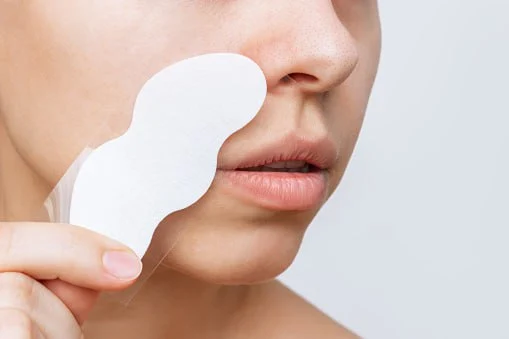Nasal strips are a simple yet effective solution to help alleviate this issue. If you’ve ever wondered how to put nasal strips on correctly, this guide is here to help.
These adhesive strips are designed to be applied externally on the outside of your nose. Your breathing and sleep quality can be dramatically improved by learning how to properly apply nasal strips.
Table of Contents
How to Put Nasal Strips On
Nasal strips may appear simple to apply, but there are a few crucial measures to make sure they work.
Step 1: Clean and Dry Your Face
Before applying a nasal strip, ensure your face is clean and dry. Gently wash your face to remove any oils or dirt affecting the strip’s adhesion.
Step 2: Position the Strip
Hold the nasal strip with both hands and position it across the bridge of your nose. The flexible strip should be placed just above the flare of your nostrils.
Step 3: Adhere the Strip
Press down on the strip’s adhesive ends to secure it in place. Make sure the strip is centered and that both ends are sticking comfortably to your skin.
Step 4: Press and Seal
With the strip in position, gently press along its length to ensure a secure seal. The strip should now be comfortably in place, lifting your nasal passages.
Step 5: Adjust as Needed
If you experience any discomfort or the strip feels too tight, you can gently adjust its position. The goal is for the strip to comfortably open your nostrils without causing irritation.
Benefits of Using Nasal Strips
Improved Breathing: By opening up your nasal passages, nasal strips allow air to flow more freely, leading to improved breathing, especially during sleep.
Reduced Snoring: Nasal strips can help reduce snoring by preventing the collapse of nostrils during inhalation, which is a common cause of snoring.
Enhanced Sleep Quality: greater breathing and less snoring result in greater sleep quality, which helps you wake up feeling more rested.
Non-Invasive Solution: Nasal strips offer a non-invasive alternative to various conventional techniques, such as nasal sprays or drugs, for enhancing nasal airflow.
Tips for Effective Nasal Strip Application
To ensure the best results, consider these tips on how to put nasal strips on:
Choose the Right Size: Nasal strips come in different sizes. Choose one that fits your nose comfortably without causing skin irritation.
Apply to Clean Skin: Make sure your face is clean and free of moisturizers or oils before applying the strip.
Proper Placement: Position the strip just above the flare of your nostrils for optimal airflow.
Gentle Pressing: Press down on the strip’s adhesive ends gently but firmly to ensure proper adhesion.
Comfort is Key: If the strip feels uncomfortable, reposition it slightly.
FAQs of How to Put Nasal Strips On
How long can I wear a nasal strip?
Nasal strips are designed for single use and should be removed before bedtime.It is advised against wearing them for longer than 12 hours.
Can I use nasal strips if I have sensitive skin?
Yes, there are nasal strips designed for sensitive skin. Look for hypoallergenic options to prevent skin irritation.
Will nasal strips completely eliminate snoring?
Although nasal strips can greatly reduce snoring, they may not completely stop it, particularly if the reason of the snoring is something other than nasal congestion.
Can I use nasal strips for a cold?
Using nasal strips during a cold can provide temporary relief, but they might be less effective if your congestion is severe.
Do nasal strips have any side effects?
Nasal strips are generally safe to use and don’t have significant side effects. However, improper application can cause minor skin irritation.
Can children use nasal strips?
It’s recommended to consult a pediatrician before using nasal strips on children, as their noses are more delicate.
Remember, a good night’s sleep begins with easy breathing. So, why not give nasal strips a try?
Here are all Health Care articles [Images collected from amazon]







